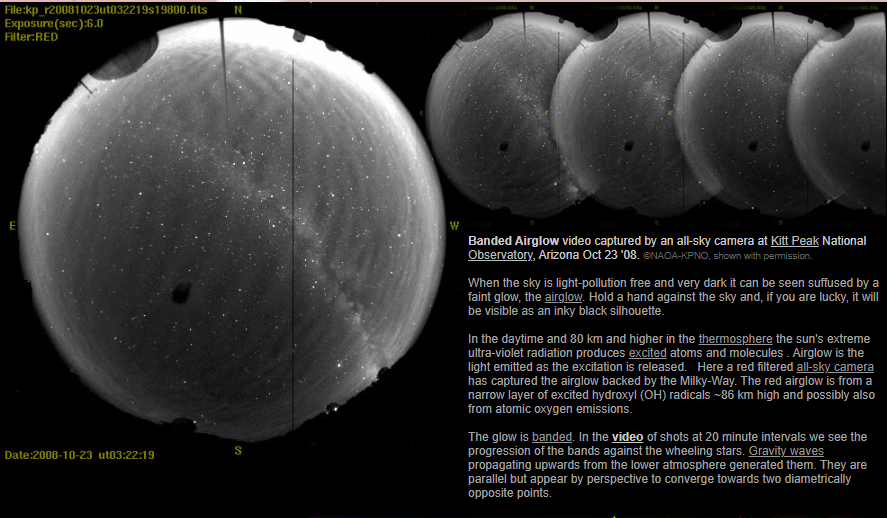Banded airglow video
Banded Airglow Video: Unveiling the Enigmatic Nighttime Sky Phenomenon
The night sky has always fascinated us with its celestial wonders. But have you ever noticed a faint glow suffusing the dark sky when it is free from light pollution? This ethereal glow is known as airglow. If you're fortunate enough to have a clear view, you might even see it as an inky black silhouette when you hold your hand against the sky.
During the daytime, in the thermosphere located approximately 80 km and higher above us, the sun's extreme ultraviolet radiation excites atoms and molecules. As these excited particles release their energy, they emit light, giving rise to the phenomenon we call airglow. A captivating example of this can be seen in a banded airglow video captured by an all-sky camera at Kitt Peak National Observatory in Arizona on October 23, 2008.
In this mesmerizing video, we witness the progression of bands of airglow against the backdrop of the wheeling stars. These bands are not randomly scattered across the sky; rather, they exhibit a fascinating pattern. Gravity waves originating from the lower atmosphere are responsible for generating these banded structures. While they may appear parallel, due to perspective, they seem to converge towards two diametrically opposite points.
The banded airglow video showcases the beauty and complexity of this atmospheric phenomenon. Let's delve deeper into some key aspects that make this video truly captivating:
-
Airglow Origins: The red airglow captured in the video primarily arises from a narrow layer located approximately 86 km above the Earth's surface. This layer consists of excited hydroxyl (OH) radicals. Additionally, atomic oxygen emissions may also contribute to the observed airglow.
-
The Role of Gravity Waves: Gravity waves, not to be confused with gravitational waves, are disturbances in the atmosphere caused by the upward propagation of buoyancy forces. These waves play a crucial role in the formation of the banded airglow pattern. As they propagate upwards from the lower atmosphere, they interact with the airglow layer, creating the mesmerizing bands we see in the video.
-
The Influence of Perspective: While the banded airglow appears parallel, it is important to note that this is a result of perspective. Due to our vantage point on Earth's surface, the bands seem to converge towards two opposite points. This convergence adds an intriguing visual element to the overall phenomenon.
-
The Impact of Light Pollution: Light pollution can hinder our ability to witness the true beauty of airglow. In areas with excessive artificial lighting, the faint glow of airglow may be masked or entirely invisible. However, in locations with minimal light pollution, such as Kitt Peak National Observatory, the banded airglow becomes more pronounced and awe-inspiring.
-
Capturing Airglow with All-Sky Cameras: The banded airglow video was captured using an all-sky camera, which provides a comprehensive view of the entire sky. These specialized cameras are equipped with wide-angle lenses that capture the celestial panorama, allowing us to witness atmospheric phenomena like airglow in their full glory.
-
Exploring Airglow's Scientific Significance: Beyond its visual allure, airglow plays a crucial role in atmospheric research. Scientists study airglow to gain insights into various aspects of our atmosphere, including its composition, temperature, and dynamics. By analyzing the patterns and characteristics of airglow, researchers can unravel the intricacies of Earth's upper atmosphere and its interactions with space.
In conclusion, the banded airglow video offers a captivating glimpse into a mesmerizing nighttime phenomenon. The interplay between gravity waves, perspective, and the excited particles in the upper atmosphere gives rise to the enchanting bands of airglow we see in the video. Through the lens of an all-sky camera, we are transported into the realm of atmospheric optics, where science and beauty converge. So, the next time you find yourself under a light-pollution-free sky, take a moment to appreciate the hidden wonders of airglow and its mesmerizing banded patterns.

Banded Airglow video captured by an all-sky camera at Kitt Peak National Observatory, Arizona Oct 23 '08. ©NAOA-KPNO, shown with permission.
When the sky is light-pollution free and very dark it can be seen suffused by a faint glow, the airglow. Hold a hand against the sky and, if you are lucky, it will be visible as an inky black silhouette.
In the daytime and 80 km and higher in the thermosphere the sun's extreme ultra-violet radiation produces excited atoms and molecules . Airglow is the light emitted as the excitation is released. Here a red filtered all-sky camera has captured the airglow backed by the Milky-Way. The red airglow is from a narrow layer of excited hydroxyl (OH) radicals ~86 km high and possibly also from atomic oxygen emissions.
The glow is banded. In the video of shots at 20 minute intervals we see the progression of the bands against the wheeling stars. Gravity waves propagating upwards from the lower atmosphere generated them. They are parallel but appear by perspective to converge towards two diametrically opposite points.

Note: this article has been automatically converted from the old site and may not appear as intended. You can find the original article here.
Reference Atmospheric Optics
If you use any of the definitions, information, or data presented on Atmospheric Optics, please copy the link or reference below to properly credit us as the reference source. Thank you!
-
<a href="https://atoptics.co.uk/blog/banded-airglow-video/">Banded airglow video</a>
-
"Banded airglow video". Atmospheric Optics. Accessed on November 26, 2024. https://atoptics.co.uk/blog/banded-airglow-video/.
-
"Banded airglow video". Atmospheric Optics, https://atoptics.co.uk/blog/banded-airglow-video/. Accessed 26 November, 2024
-
Banded airglow video. Atmospheric Optics. Retrieved from https://atoptics.co.uk/blog/banded-airglow-video/.